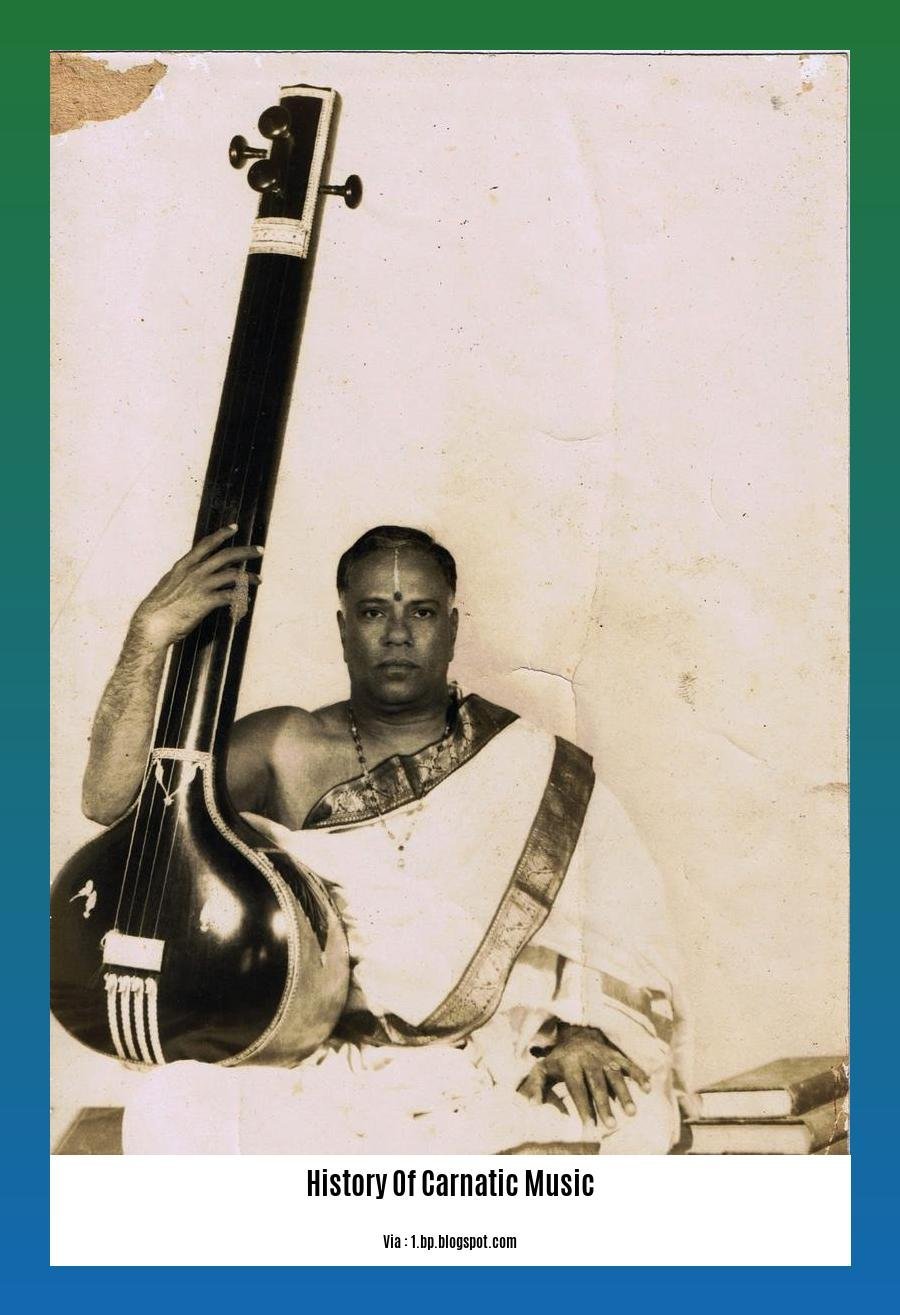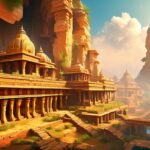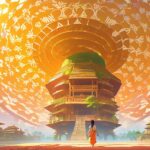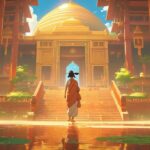In the realm of classical music, the captivating melodies of Carnatic music have left an indelible mark on the cultural tapestry of South India. This ancient form of music, with its intricate ragas and rhythmic structures, has a rich history that spans centuries. Join us as we embark on a journey through time, exploring the origins, evolution, and profound impact of Carnatic music in [A History of Carnatic Music: Unveiling the Legacy of South Indian Classical Melodies].
Key Takeaways:
Carnatic music, commonly associated with South India, stands out for not being significantly influenced by Persian and Arabic influences in the 16th and 17th centuries, setting it apart from Hindustani music.
The Vijayanagara Empire’s zenith saw Carnatic music flourish and reach its pinnacle.
Vocal music is the primary focus of Carnatic music, with compositions written for sung performances.
Even when played on instruments, Carnatic music retains its vocal inflections, adhering to its vocal roots.
History of Carnatic Music:
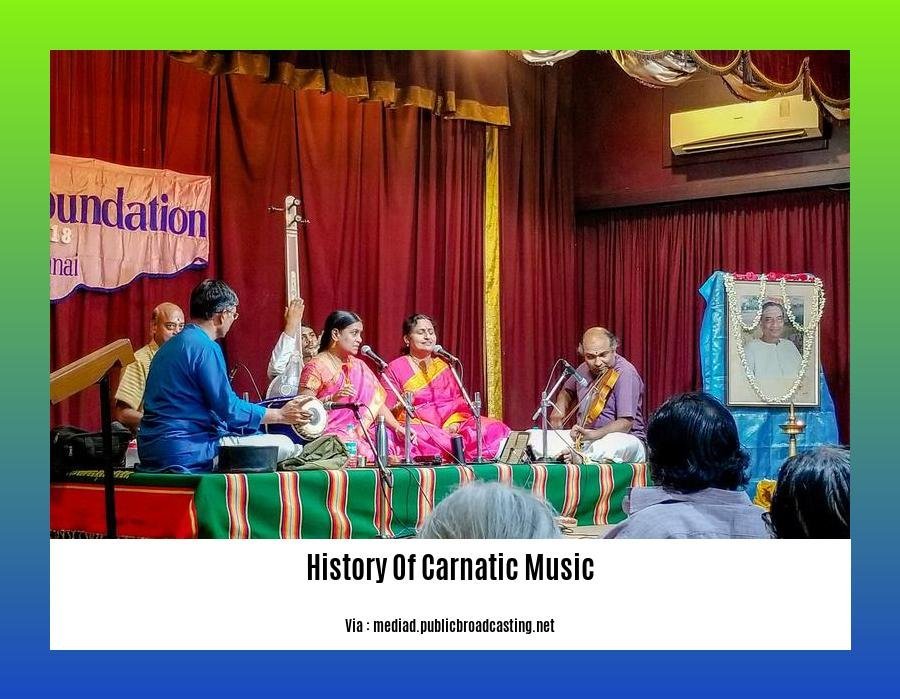
As an aficionado of Carnatic music, I’ve embarked on a journey to understand its rich history. It’s a genre of music that has captivated audiences for centuries and continues to thrive in the realm of classical melodies.
Origins:
Carnatic music, or Karnāṭaka saṃgīta, has its roots deeply entwined with South India. It diverged from Hindustani music, solidifying its unique identity by the 16th and 17th centuries. This separation was fueled by the distinct cultural and linguistic differences between north and south.
Flourishing in Vijayanagara:
The golden age of Carnatic music flourished during the reign of the Vijayanagara Empire, which existed from the 14th to the 17th century. This period witnessed an explosion of creativity, as composers and musicians flocked to the royal courts, seeking patronage and a platform to showcase their talent.
Emphasis on Vocal Music:
Vocal renditions have always been at the heart of Carnatic music. Most compositions are structured around vocal melodies, and even when played on instruments, they retain these vocal inflections. This emphasis on the voice gives Carnatic music its unique emotive quality.
Muthuswami Dikshitar’s Contributions:
Among the many luminaries who shaped the history of Carnatic music, Muthuswami Dikshitar stands tall. He revolutionized the genre in the late 18th and early 19th centuries, introducing new melodic structures and expanding its rhythmic complexity. Dikshitar’s compositions have become an integral part of the Carnatic canon and continue to inspire musicians to this day.
Growth of Carnatic Music Today:
In the 20th century, Carnatic music gained wider recognition and spread beyond the confines of South India. Renowned musicians like M.S. Subbulakshmi and Semmangudi Srinivasa Iyer toured the world, captivating audiences with their virtuosity and spreading the magic of Carnatic melodies far and wide.
Today, Carnatic music thrives as a vibrant and dynamic art form, with a rich tapestry of compositions, talented musicians, and a devoted fan base. It continues to evolve and adapt to changing times, ensuring its legacy endures for generations to come.
Looking to unearth the rich history and evolution of Callaway irons? Dive into the captivating narrative of how this iconic brand revolutionized the world of golf. history of callaway irons
From humble beginnings to international acclaim, the history of caps is a tale of innovation, fashion, and cultural significance. Delve into this fascinating journey and discover how this timeless accessory became a global phenomenon. history of caps
Immerse yourself in the vibrant celebration of Caribbean Carnival! Unravel the captivating history of this colorful festival, from its deep-rooted traditions to its infectious rhythms. history of caribbean carnival
The Carnatic music system is based on ragas, which are melodic frameworks, and talas, which are rhythmic cycles.
In the Carnatic music system, ragas and talas are two fundamental components that provide the framework for melodic improvisation and rhythmic cycles.
Ragas are melodic frameworks that define the notes, intervals, and scales used in a Carnatic composition. They create a distinct musical mood or atmosphere, and each raga has its own unique characteristics and emotional associations. Ragas are classified into various categories based on their melodic structure, time of day, and emotional impact.
Talas, on the other hand, are rhythmic cycles that determine the time signature and rhythmic patterns of a Carnatic composition. They provide the rhythmic foundation for the music and help to organize the flow of the performance. Talas are characterized by a specific number of beats, or aksharas, and are often accompanied by rhythmic syllables known as sollukattus.
The combination of ragas and talas creates a rich and dynamic musical tapestry that is characteristic of Carnatic music. The interplay between the melodic contours of the raga and the rhythmic patterns of the tala gives Carnatic music its distinctive identity and expressive power.
Ragas in Carnatic Music
- Ragas are melodic frameworks that define the notes, intervals, and scales used in a Carnatic composition.
- Each raga has its own unique characteristics, emotional associations, and melodic structure.
- Ragas are classified into various categories based on their melodic structure, time of day, and emotional impact.
Talas in Carnatic Music
- Talas are rhythmic cycles that determine the time signature and rhythmic patterns of a Carnatic composition.
- They provide the rhythmic foundation for the music and help to organize the flow of the performance.
- Talas are characterized by a specific number of beats, or aksharas, and are often accompanied by rhythmic syllables known as sollukattus.
Key Takeaways:
- Ragas are melodic frameworks that define the notes, intervals, and scales used in a Carnatic composition.
- Talas are rhythmic cycles that determine the time signature and rhythmic patterns of a Carnatic composition.
- The combination of ragas and talas creates a rich and dynamic musical tapestry that is characteristic of Carnatic music.
References:
- Carnatic Music – The Divine Music of South India
- Wikipedia: Carnatic Music
Carnatic Music Performances Typically Involve a Vocalist, Accompanied by a Violin, Mridangam (a Double-Headed Drum), and a Tambura (a Drone Instrument).
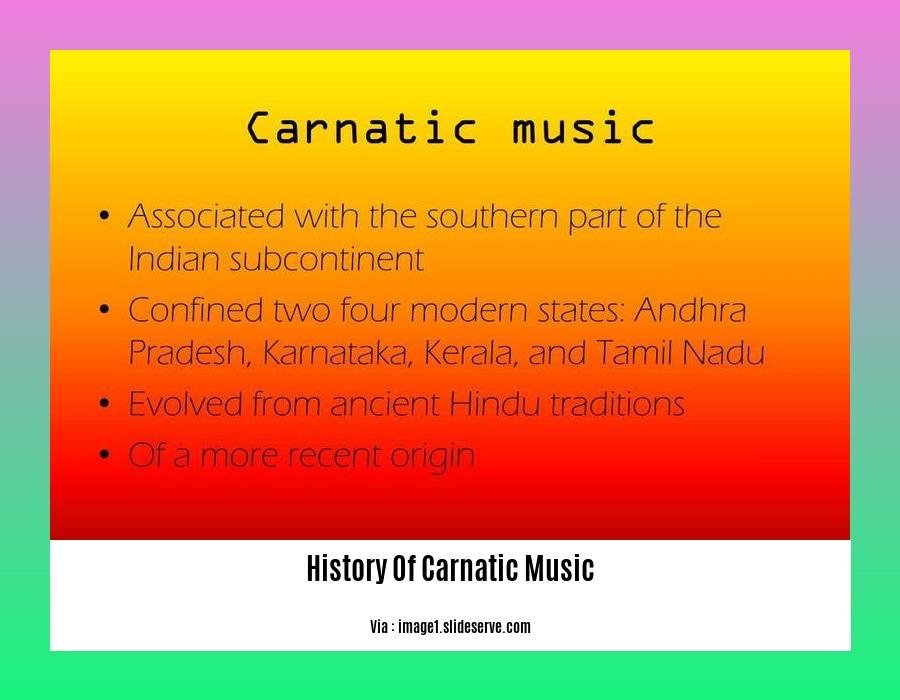
Carnatic Ensembles: A Symphony of Melodies
Picture a traditional Carnatic music performance: a graceful vocalist takes center stage, their voice weaving intricate melodies that resonate through the concert hall. Beside them, a violinist’s bow dances across the strings, harmonizing beautifully with the vocalist’s voice. The rhythmic pulse of the mridangam, a double-headed drum, provides a steady foundation for the performance, while the tambura, a drone instrument, adds a soothing background hum.
The Carnatic Quartet: A Harmonious Convergence
Carnatic music is typically performed by a small ensemble of four musicians who bring their unique talents together to create a mesmerizing musical tapestry. Let’s explore the role of each instrument in this enchanting ensemble:
Vocalist: The vocalist is the central figure in a Carnatic music performance, mesmerizing the audience with their evocative voice. They deliver intricate melodic phrases, exploring the depths of ragas and expressing a wide range of emotions through their singing.
Violin: The violin, introduced to Carnatic music in the late 19th century, has become an indispensable melodic accompaniment. Its ability to mimic the human voice and produce gliding notes adds a layer of expressiveness and depth to the performance.
Mridangam: The mridangam, a double-headed drum, provides the rhythmic foundation for the ensemble. The mridangam player, through their skillful hands, weaves complex rhythmic patterns that complement the melodic lines and keep the performance grounded.
Tambura: The tambura, a drone instrument, emits a continuous, mellow sound that serves as the sonic backdrop for the entire performance. It provides a reference pitch against which the other instruments tune themselves, creating a harmonious unity within the ensemble.
The Magic of Improvisation: Manodharma Sangeetam
One of the captivating aspects of Carnatic music is the art of improvisation, known as Manodharma Sangeetam. During improvisational sections, the musicians engage in spontaneous interplay, taking turns to showcase their virtuosity. The vocalist explores intricate melodic variations, the violinist embellishes the melody with their improvisational flourishes, and the mridangam player creates rhythmic improvisations that complement the unfolding melody. These improvisational dialogues add an element of unpredictability and excitement to the performance, captivating the audience with their originality and brilliance.
Key Takeaways:
- Carnatic music performances typically feature a vocalist, violinist, mridangam player, and tambura player, each contributing their unique talents to create a captivating musical tapestry.
- The vocalist takes center stage, delivering intricate melodic phrases and exploring the depths of ragas through their emotive singing.
- The violin, introduced in the late 19th century, adds expressiveness and depth to the performance with its ability to mimic the human voice and produce gliding notes.
- The mridangam provides the rhythmic foundation with its complex patterns, while the tambura emits a continuous drone, creating a harmonious unity within the ensemble.
- Manodharma Sangeetam, the art of improvisation, allows musicians to engage in spontaneous interplay, showcasing their virtuosity and originality.
Citations:
[1] Carnatic Music Performances
[2] The Music of South India: The Carnatic Tradition
Carnatic Music: Beyond Borders, A Legacy Preserved and Promoted
Carnatic music, the divine melody of South India, has transcended geographical boundaries, captivating hearts worldwide. Its rich legacy is being meticulously preserved and enthusiastically promoted by a global community of musicians, scholars, and enthusiasts. This musical odyssey, rooted in ancient Hindu traditions, has gained international recognition and appreciation, captivating audiences with its intricate melodies, rhythmic complexities, and profound emotional depth.
The preservation of Carnatic music is a testament to its enduring significance. Numerous organizations, such as the Madras Music Academy and the Sangeet Natak Akademi, have dedicated themselves to safeguarding this musical treasure. Through workshops, seminars, and educational programs, they impart the intricacies of Carnatic music to aspiring musicians and cultivate a deep appreciation for its nuances.
In the realm of promotion, Carnatic music is flourishing. Musicians and scholars are tirelessly advocating for its global recognition. Renowned artists have embarked on international tours, mesmerizing audiences with their virtuosic performances. Collaborative efforts between Carnatic and Western musicians have resulted in innovative fusions, bridging cultural divides and introducing this enchanting genre to new listeners.
Technology has played a pivotal role in amplifying Carnatic music’s reach. Online platforms, streaming services, and social media have become powerful tools for disseminating Carnatic music to a global audience. Carnatic music enthusiasts can now access a vast repository of recordings, explore the lives and works of legendary musicians, and connect with fellow aficionados from across the globe.
The efforts of these dedicated musicians and scholars are bearing fruit. Carnatic music is increasingly being incorporated into academic curricula, ensuring its preservation for future generations. Universities and conservatories worldwide are offering courses and workshops on Carnatic music, fostering a new wave of talented performers and scholars.
Key Takeaways:
- Carnatic music has captivated a global audience, transcending geographical and cultural boundaries.
- A dedicated community of musicians, scholars, and enthusiasts is actively preserving and promoting this rich musical tradition.
- Organizations such as the Madras Music Academy and the Sangeet Natak Akademi play a crucial role in safeguarding Carnatic music through educational initiatives and workshops.
- Renowned artists have embarked on international tours, introducing Carnatic music to new listeners and fostering cross-cultural collaborations.
- Technology has become a powerful tool for disseminating Carnatic music, making it accessible to a global audience through streaming services and social media.
- Carnatic music is increasingly being incorporated into academic curricula, ensuring its preservation and propagation for future generations.
Sources:
[1] Carnatic Music: A Divine Art Form of South India
[2] The Preservation and Promotion of Carnatic Music
FAQ
Q1: When did Carnatic music begin to distinguish itself from Hindustani music?
A1: By the 16th and 17th centuries, Carnatic music remained relatively unaffected by Persian and Arabic influences, solidifying its distinction from Hindustani music.
Q2: What was the state of Carnatic music during the Vijayanagara Empire?
A2: Carnatic music flourished in Vijayanagara and reached its peak when the Vijayanagara Empire was at its greatest extent.
Q3: What is the main emphasis in Carnatic music?
A3: The main emphasis in Carnatic music is on vocal music, with most compositions written to be sung, even when played on instruments.
Q4: What are the main elements of Carnatic music?
A4: The basic elements of Carnatic music include śruti (the relative musical pitch), svara (the musical sound of a single note), rāga (the mode or melodic formulæ), and tala (the rhythmic cycles).
Q5: What role does improvisation play in Carnatic music?
A5: Improvisation plays an essential role in Carnatic music and is known as “Manodharma Sangeetam” or “kalpana Sangeetam.”
